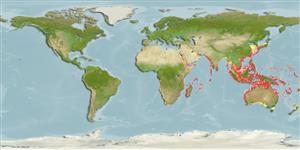分类 / Names
俗名 | 同种异名 | Catalog of Fishes (gen., sp.) | ITIS | CoL | WoRMS | Cloffa
Actinopterygii
辐鳍鱼纲 (条鳍鱼) >
Perciformes (Perch-likes) >
Scombridae (Mackerels, tunas, bonitos) > Scombrinae
Etymology: Scomberomorus: Latin, scomber = mackerel + Greek, moros = silly, stupid (Ref. 45335).
环境 / 气候 / 范围
生态学
; 海洋; 海洋洄游的 (Ref. 51243); 深度上下限 10 - 70 m (Ref. 12260). , preferred 27°C (Ref. 107945); 39°N - 41°S, 7°W - 180°E (Ref. 54880)
Indo-West Pacific: Red Sea and South Africa to Southeast Asia, north to China and Japan and south to southeast Australia, and to Fiji (Ref. 6390). Immigrant to the eastern Mediterranean Sea by way of the Suez Canal. Southeast Atlantic: St. Helena.
Length at first maturity / 大小 / 重量 / 年龄
Maturity: Lm 85.0, range 55 - 82 cm
Max length : 240 cm FL 雄鱼/尚未辨别雌雄; (Ref. 5765); common length : 120 cm TL 雄鱼/尚未辨别雌雄; (Ref. 5450); 最大体重: 70.0 kg (Ref. 5765)
背棘 (总数): 15 - 18; 背的软条 (总数): 15-20; 臀棘 0; 臀鳍软条: 16 - 21; 脊椎骨: 42 - 46. Interpelvic process small and bifid. Swim bladder absent. Lateral line abruptly bent downward below end of second dorsal fin. Intestine with 2 folds and 3 limbs. Vertical bars on trunk sometimes break up into spots ventrally which number 40-50 in adults, and less than 20 in juveniles. Juveniles with large oval dark spots on body; middle third of first dorsal fin white, rest of fin black (Ref. 11228).
Distributed from near edge of continental shelf to shallow coastal waters, often of low salinity and high turbidity (Ref. 30199, 48637). Also found in drop-offs, and shallow or gently sloping reef and lagoon waters (Ref. 1602, 48637). Usually hunts solitary and often swim in shallow water along coastal slopes (Ref. 48637). Known to undertake lengthy long-shore migrations, but permanent resident populations also seem to exist. Found in small schools (Ref. 9684). Feed primarily on small fishes like anchovies, clupeids, carangids, also squids and penaeoid shrimps. Eggs and larvae are pelagic (Ref. 6769). A lipid-soluble toxin, similar to ciguatoxin has been found in the flesh of specimens caught on the east coast of Queensland, Australia. Marketed fresh, dried-salted (Ref. 9684), frozen, smoked, and canned (Ref. 9987); commonly made into fish balls.
Life cycle and mating behavior
成熟度 | 繁殖 | 产卵场 | 卵 | 孕卵数 | 仔鱼
Depending on temperature regime, the spawning season may be more or less extended.
In Australian waters, each female spawns several times over the season, about 2 to 6 days apart (Ref. 30196), depending on the locality. Spanish mackerel spawn off the reef slopes and edges, and they form spawning aggregations in specific areas (Ref. 6390).
Collette, B.B. and C.E. Nauen, 1983. FAO Species Catalogue. Vol. 2. Scombrids of the world. An annotated and illustrated catalogue of tunas, mackerels, bonitos and related species known to date. Rome: FAO. FAO Fish. Synop. 125(2):137 p. (Ref. 168)
CITES (Ref. 94142)
Not Evaluated
人类利用
渔业: 高经济性; 游钓鱼种: 是的
工具
特别资料
下载 XML
网络资源
